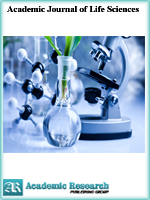Academic Journal of Life Sciences
Online ISSN: 2415-2137
Print ISSN: 2415-5217
Print ISSN: 2415-5217
Quarterly Published (4 Issues Per Year)

Archives
Volume 2 Number 10 October 2016
Determinations of Some Heavy Metals and Elements in Moringa oleifera Leaves Cultivated in Gulani Town, North ? Eastern Nigeria
Authors: Gwana Adamu Mohammed ; Effiong Edet Bassey ; Halima Bala Mohammed ; Muhammed Alhaji Bashir ; Buhari Bagudu Yawuri ; Abubakar Musa ; Ali Garba
Pages: 77-83
Abstract
This research study was conducted on the determinations of some heavy metals and elements in Moringao leifera leaves that were grown in Gulani town, North – Eastern Nigeria. Fresh plant part materials were sampled and prepared as the method described by Gwana, et al. [1]. The prepared sampled were analysed by using the Atomic Absorption Spectrophptometric techniques as described by Association of Official Analytical Chemists [2].The study revealed the presence of heavy metals and elements determined and their mean concentration levels were ranged from 0.17 to 89.0 µg / l; Ca (89.0 µg / l), Cd (0.26 µg / l), Cr (0.17 µg / l), K (6.5 µg / l), Mn (0.68 µg / l), Pb (not detected) and Zn (0.32 µg / ). With regard to their percentage of concentration were ranged from 0.17 % to 91.8 %; Ca (91.8 %), Cd (0.27 %), Cr (0.17 %), K (6.7 %), Mn (0.68 %), Pb (0 %) and Zn (0.32 %) The magnitude of concentration levels of these elements detected in M. oleifera plant parts materials’ in sequential order was Ca>K>Mn>Zn>Cd>Cr> Pb, the highest mean concentration was calcium (Ca), the least was chromium, lead was not detected. M. oleifera leaves cultivated in this area were rich in minerals, both macro and micro elements, did not exceed the standard recommended values for heavy metals, found health risks free, wholesome for consumption(in terms of the minerals determined)by human beings and animals. The results obtained support the works of Ibrahim and Jimoh [11], Qais, et al. [12]; Okoronko, et al. [15] amongst others. Studies need to be carried out in the studied area in order to determinethe other heavy metals and elements that are not involved in this study.



